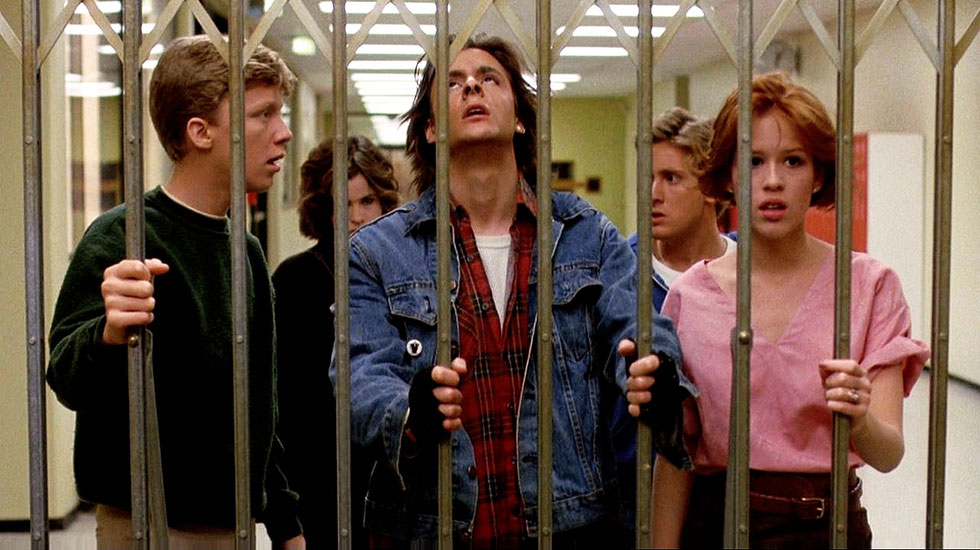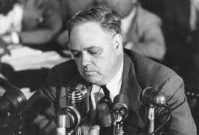Doing Time with John Hughes
The fanfare surrounding the 30th anniversary of The Breakfast Club may puzzle some people—anybody, in fact, who wasn’t born between 1966 and 1979 in the United States of America. Those of us who are older (as I am) or younger than that might well have missed “the movie that defined a generation.” The writer-director John Hughes made The Breakfast Club as the second in what became a trilogy of teen movies, in between Sixteen Candles (1984) and the box-office smash Ferris Bueller’s Day Off (1986).
“John Hughes raised me,” said Nicolle Wallace (born 1972) on The View. Last month, Wallace and her cohost Whoopi Goldberg interviewed Judd Nelson, one of The Breakfast Club’s cast members, as commemorative showings of the film were taking place in hundreds of movie theaters across the country.
Wallace said she took to heart its message: that within each of us is “a brain, an athlete, a basket case, a princess, and a criminal.”
“You brought an entire generation forward who had no direction to look at, and they found you guys,” Goldberg told Nelson, adding, “my kid [was] one of those kids.” He responded by talking about John Hughes, “the first director and writer to treat young people not like they were less. They were just less old. But they had the same problems.”
It may be this coming-of-age movie from 1985 is a cultural phenomenon that’s beyond critical analysis—but here goes. Let us view it with an eye to what it might be saying about authority, rebellion, institutions, family, and the possibility of love.
The praise from Breakfast Club fans does not mention rebellion very much. This in itself is interesting, for it has more than its share of railing against the tyranny of adults. As Hughes once said, “At that age, it feels as good to feel bad as it does to feel good.”
His characters rebel but not in a political way. This has to be one reason so many young people of the time embraced the movie—the counterculture was there, but it had receded in prominence. I should add that there is one exception to this, but it’s only a partial exception: Judd Nelson’s juvenile delinquent character, called John Bender, is mad at the world and envious of kids who are materially better off than he. He imagines their home lives to be as placid as his is contentious. (He finds out differently, of course.)
This kid challenges his classmates with rude questions (“Are you a virgin?”) but there’s nothing in his insults or outbursts to indicate a future life of anti-capitalist activism, or even social work. Possibly, then, what he yearns for is a piece of the American Dream. Indeed, when he first meets the movie’s popular-student character, an upper middle class girl played by Molly Ringwald, she pegs him as one of those malcontents who underneath it all just wants to belong. And the movie completes this thought, ending with a romance between the two of them.
Does any of this mean that John Hughes, who died in 2009, was a conservative? His friend and former colleague P.J. O’Rourke, who edited Hughes’ contributions to National Lampoon magazine in the late 1970s, says he was.
“There’s nothing revolutionary about The Breakfast Club. On purpose. The kids don’t try to abolish authority and institutions. They elude and modify them with wit,” observed O’Rourke in a commemorative essay in the Daily Beast.
He goes further, writing that he considers the movie’s high schoolers to be “operating upon the three basic principles in The Wealth of Nations,” namely “pursuit of self-interest, division of labor and freedom of trade.” But maybe this is O’Rourke being playful, as is O’Rourke’s wont. “Freedom of trade is the message of the movie. Albeit the trade is conducted in the coin of the adolescent realm, love.”
The adults in Hughes’ movies (as in nearly all pop culture creations aimed at the young) are either morally bankrupt or silly. Is this conservative? Maybe Aristophanes-style conservative—but not really Adam Smith conservative. Another point to consider is that, while O’Rourke doesn’t mention the subject of baby boomers here (and I’ll get to them in a minute), he and Hughes shared an inclination to criticize them. That isn’t necessarily conservative, but it is deserved.
O’Rourke has written a heartfelt tribute to a deceased friend; it may be out of place to poke at it. In any case I’m of the opinion that John Hughes’ gift to teen pictures was not so much conservatism, but drama. He made sure his was, like other teen pictures, funny, profane, romantic, musically infectious, and also gross. (Ally Sheedy, as the artistically gifted “basket case,” makes an ink pen drawing and then adorns it with her own dandruff.) But a difference between The Breakfast Club and, say, Porky’s (1982), Fast Times at Ridgemont High (1982), or Risky Business (1983) strikes the viewer almost immediately. Once its main characters are assembled, it doggedly stays in that scene for what seems like forever.
Call it group-therapy drama if you want—it has been, at any rate, a staple of the American stage and screen from at least the 1950s on. It was in 1956, recall, that Eugene O’Neill took audiences on a Long Day’s Journey Into Night. In the wake of O’Neill’s works (and those of Strindberg and Chekhov, O’Neill’s models), theatergoers and viewers of the then-new medium of television were subjected to a long night of soul-searching (Paddy Chayefsky’s 1957 The Bachelor Party), a long day of deliberation (Reginald Rose’s 1957 Twelve Angry Men), a long weekend of family confrontation (Edward Albee’s 1964 A Delicate Balance), and other place-limited, time-elongated situations.
Enforced togetherness is where people tell each other brutal truths and reach personal epiphanies. And John Hughes’ people manage to do this in a comedy, with farcical dance scenes, chase scenes, and epithets like “dork” and “sporto” flying around. The normal teen-movie elements, flashy as they are, are only accents. What Hughes is really doing is cleverly uniting that genre with the tension-generating, group-therapy prototype.
He condensed the time frame in all of the pictures in his teen trilogy. Chances are that The Breakfast Club is the one that came to “define a generation” because it condensed so intensely. It’s about detention. How trite—but also how sly—to use a place every American school kid knows about (whether firsthand or not), and represent there all of the categories that school kids put themselves in. A popular girl, a juvenile delinquent, a nerd, a jock, and an artist-misfit sit detention together in the library of the fictional Shermer High School in a northern suburb of Chicago.
In a funny twist, their “jailer,” the teacher played by Paul Gleason, is as unhappy as they are to be stuck at Shermer High for eight hours on a Saturday. Keeping confidentiality, he never announces why any of them is being punished. Thus, at intervals along the way, dramatic moments are created when each reveals what misdeed landed him or her there.
If it’s trite, as I say, it’s trite like a fox, for as Vanity Fair’s David Kamp wrote in a perceptive 2010 profile of Hughes: “The elements that grown-ups perceived as ponderous and risible were precisely what made the movie so real to teens.”
Also real, more or less, was the dialogue. Characters in The Breakfast Club display wit, but their range of reference almost never strays from what 15-to-18-year-olds in vast suburban public high schools think about.
The result is a kind of naturalism—a refreshing reminder of how movies and television used to sound as compared to how they sound today. Hughes respected these creations of his more than the current crop of writers respect the beings who populate, say, Justified, Black-ish, or Better Call Saul. Nowadays, characters who are supposed to be ordinary Joes are likely to blurt out bits of cultural critique or indicate a familiarity with the classics of cinema. This kind of dialogue is intended to add zest (or to show off the liberal arts educations of today’s scriptwriters). Instead it puts speed bumps on the road to the suspension of your disbelief.
Consider, for example, the sitcom Modern Family. The Dunphy kids, two out of three of whom are cute but unintelligent, can come across like Oscar Wilde as filtered through Elmore Leonard. The son, supposedly a slow learner, in tangling with his dad says: “It’s called growing up and having my own interests, just like the preacher’s daughter in your precious Footloose.”
I chose that line for its inauthenticity. But I’d like to switch to pondering its substance, which recalls John Hughes’ generational mission with his films. Those baby boomers and their precious Footloose, indeed. Their precious nostalgia trips—courtesy of George Lucas (American Graffiti, 1973) or Barry Levinson (Diner, 1982) or others—dominated the cinematic landscape. Teens of the post-baby boom were invisible, John Hughes felt. (This domination, if anything, continued after his trilogy was made, with highly successful and/or critically acclaimed pictures like Dirty Dancing and Hairspray, made in 1987 and 1988, respectively.)
Hughes, a filmmaker in his 30s, wanted those just coming of age to have their pop culture moment. Only the most modern clothing styles and music—“the 80s alterna-pop” for which Hughes was known, says Kamp—are in The Breakfast Club. No Fonzies with pompadours. The dialogue and gestures came, at least in part, from improvisation by his ensemble of actors (who, besides Nelson, Sheedy, and Ringwald, included Emilio Estevez and Anthony Michael Hall).
The filmmaker’s tenderly protective feelings toward the young reached Holden Caulfield levels, and in fact he was not above recycling The Catcher in the Rye in movie form. “When you grow up, your heart dies,” declares one of the students to her detention-mates. The movie’s obsession with how unfeeling adults are was greeted as remarkably original by those who were Molly Ringwald’s age at the time, but of course it wasn’t. Hughes was giving this cohort its say, but what the young say is often what the young have always said. They, being young, don’t know this.
Alfred Lord Tennyson once described himself as a “second-rate sensitive mind” and perhaps this fits John Hughes. Tennyson’s poems nonetheless are remembered; so is Hughes’ trilogy of movies, and that is no small accomplishment. The Breakfast Club stands, moreover, as a curiously poignant sign of where we’ve gotten to in three decades’ time. Its world has the look, the feel, and the musical beat of our world but a moment’s reflection discloses the differences.
There’s not a computer screen visible in the entire film; social media, of course, did not exist then. Hughes’ high schoolers were bored, but they weren’t all that distracted. Would kids today be able to concentrate on each other’s physical presence long enough to create the esprit d’ corps that forms in eight straight hours of detention in this story?
More dire than that, the D student we see striding defiantly around the school grounds—the cool cat John Bender, with a grievance on his tongue and a switchblade in the pocket of his ostentatiously long overcoat—has gone psychopathic. Shuddering at Columbine, and all of the school horrors that have followed, we long to believe that friendship and community will be ours if we but let down our guard, disclose our personal hurts, and thus transcend them. We long to believe that in our John Benders we see the beginnings of men, not unredeemable monsters.
But the hopefulness of The Breakfast Club hardly seems tenable today. Nor do the big script writers, sophisticates all, seem interested in preserving the naturalism I spoke of, which might not impress elite audiences but can obviously reach other Americans when skillfully done.
Conclusion: The next cinematic enchantment of a broad base of young people, a piece of generation-uniting pop culture that will linger in minds and hearts for years and years, is going to be long in coming. If one ever comes again.



